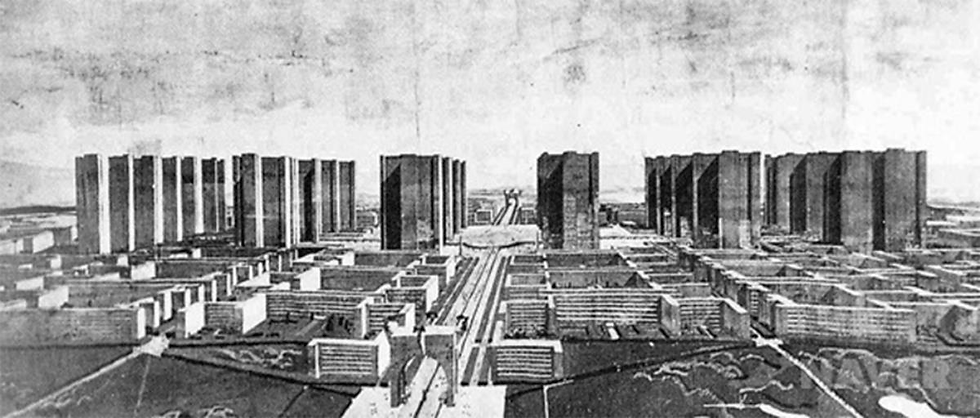How We Should Be Thinking About The Built Environment
- Zoeanna Upadhyay

- Aug 1, 2021
- 4 min read
Zoeanna Upadhyay
The notion that the only function of an Architect is to design new buildings and cityscapes is an outdated one. The role of an Architect today is far more complex- it is to understand the nature of the built environment first, and then find better ways in which citizens can occupy space, consume less and live better quality lives.
The built environment is an example of a complex system; a system that requires a multi-disciplinary approach because the problems it poses are too complex to be judged, much less solved with the knowledge of a single discipline (Hübenthal, 1994). I believe it is essential that professionals studying Architecture, Urban planning and design approach these problems with an open methodology-understanding the advantages and disadvantages of each method and developing the creativity, flexibility and scientific thinking required in this field. For instance, problems like traffic congestion, poor infrastructure, and overpopulation aren't always the result of insufficient money, but rather of not having a correct understanding of the way cities and towns operate.
To start, let’s look at the built environment through a lens of complexity. This means not treating it as an isolated system but as a composition of several different variables that interact with each other and with other external factors simultaneously in many different ways. These include physical, ecological, social, political, cultural and economic relationships that function at different scales and are integrated into an organic whole.
A study based in the Netherlands simulated the activity-travel patterns of individuals based on their daily scheduling decisions. The study found that people's observations, knowledge and understanding of the built environment influence their choices and habits (Cenani, Sehnaz & Arentze, Theo & Timmermans, H.J.P., 2012). People's behaviour patterns and how they interact with the environment enables planners to make better decisions about how transportation and land can be organized. Better connectivity, proximity to services and safety influence the walkability of the streets, which affects the overall health of the population. The healthier the population, the more likely they are to walk. It is all incredibly circular logic, showing the cause and effect of different disciplines within a city.
So, how exactly is complexity thinking useful as a framework for exploring the built environment and building healthy, sustainable and equitable communities? Firstly, it introduces us to the concept of “Systems thinking” a holistic approach to analysis that focuses on how the effects of balancing processes and multiple-feedback loops affect the integrated whole. A building is not just a building, it is also an aesthetic, a source of income, a place of shelter, and interaction with its physical environment and the people who inhabit it. It is so integrated into its surroundings, it cannot be thought of as a distinct individual entity. 'Systems thinking' lets us deconstruct these complex situations and highlight important patterns and relationships, their impacts and the role interventions and policies can make in ensuring a better quality of life. It lets us build realistic models and simulations of situations without reducing them to over-simplistic misrepresentations.
It encourages designers to work with policymakers, health professionals, thinkers, writers and regular citizens, to develop interventions that will have the most impact on the built environment. Introducing these modes of thought allow us to break away from previous templates of urban planning and deal with real, specific problems more effectively instead of falling into abstract, ‘utopian’ thought patterns. As Don Norman said, “We must design for the way people behave, not for how we would wish them to behave.”(Norman, 2011) The built environment is not a passive component, but an actively transforming system that needs to be treated as such. Over the last few years, there is a reduced emphasis on automobiles and increased demand for public transport and pedestrian-friendly roads. This is just one example of how shifting values and culture affect city planning. There needs to be enough flexibility to allow urban ecosystems to evolve spontaneously. As professionals working with the built environment, this model of thinking allows us to explore questions of “what if?”. It lets us test theories, debate and reflects on human behaviour and social environments. It is a methodology that involves multiple scientific strategies of thought and computational models. It uses inductive reasoning- reasoning from particulars to the general, rather than the reverse (Jacobs, 1961). These are essential tools that force us to step outside the traditional boundaries of planning and embrace the complexities of the built environment.
References
Boussabaine, H. A. (2008). Embracing Complexity in the Built Environment. United Kingdom: Earthscan.
Williams, L. M. (2013). Getting To Know The Built Environment As A Complex System. Toronto: Weslley institute.
Jacobs, J. (1961) “The death and life of Great American Cities”, New York: Random House
Nicholas Taleb, N. (2008), “The Fourth Quadrant: A map of the limits of statistics”, Edge.org. Retrieved from https://www.edge.org/conversation/nassim_nicho
Czarnecki, K.(2012). “What Is Systems Thinking?”, School Library Journal, 58(2):22-n/a
Cenani, Sehnaz & Arentze, Theo & Timmermans, H.J.P. (2012). A Cognitive Learning Model for Dynamic Activity-travel Patterns. Procedia - Social and Behavioral Sciences. 54. 580–588. 10.1016/j.sbspro.2012.09.775.
Newell, William. (2001). A Theory of Interdisciplinary Studies. Issues in Integrative Studies. 19. 1-26.
ArchDaily. (2017). “Why are Architects needed?”[Video] YouTube. Retrieved from https://www.youtube.com/watch?v=kn5Gq1l8UmE&t=205s
Sotiropoulos, D. Tedx Talks. (2015). “What is the role of an Architect today?”[Video], YouTube. Retrieved from https://www.youtube.com/watch?v=IgGhXUKg9ns\
Hillier, B. and Hanson, J. (1984) The Social Logic of Space, New York: Cambridge University Press.
Norman, D. A. (2011). Living with complexity. Cambridge, Mass: MIT Press.
Hübenthal, U. (1994). Interdisciplinary thought. Issues in Integrative Studies, 12, 55-75.






Comments